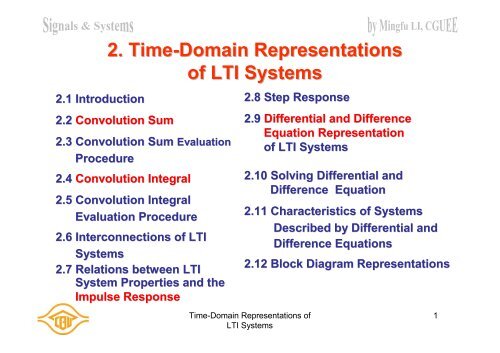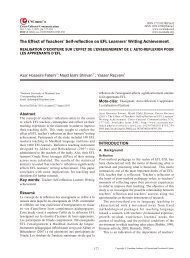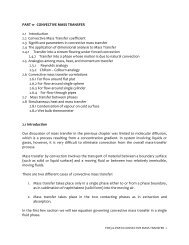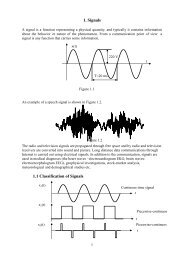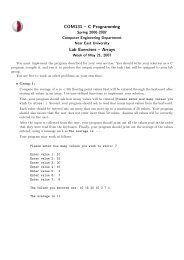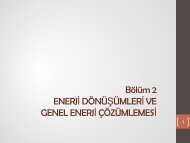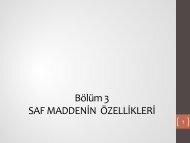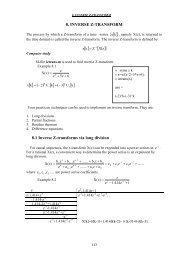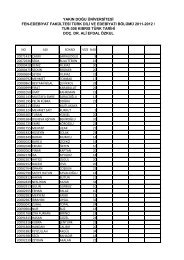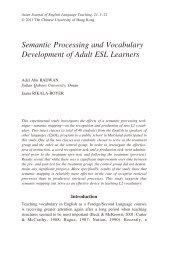2. Time-Domain Representations of LTI Systems
2. Time-Domain Representations of LTI Systems
2. Time-Domain Representations of LTI Systems
Create successful ePaper yourself
Turn your PDF publications into a flip-book with our unique Google optimized e-Paper software.
<strong>2.</strong> Impulse Response <strong>of</strong> <strong>LTI</strong> System HOutput:Input x[n]<strong>LTI</strong> systemHyn H x n H x k n kk y n H x k n kk k <strong>2.</strong>2 Convolution Sumy [ n] x[k]H{[n k]}Linearity(<strong>2.</strong>2)Output y[n]HomogeneityThe system output is a weighted sum <strong>of</strong> theresponse <strong>of</strong> the system to time-shifted impulses.For time-invariant system:H{ [n k]} h[ n k] (<strong>2.</strong>3)h[n] = H{[n]} impulseresponse <strong>of</strong> the <strong>LTI</strong> system Hk y [ n] x[k]h[n k](<strong>2.</strong>4)Convolution process:Fig. <strong>2.</strong><strong>2.</strong><strong>Time</strong>-<strong>Domain</strong> <strong>Representations</strong> <strong>of</strong><strong>LTI</strong> <strong>Systems</strong>4
3. ConvolutionSum x n h n x k h n kk <strong>2.</strong>2 Convolution Sumx[ 1][n 1]x[ 0] [n]x[ 1] n [ 1]x[ 2] n [ 2] kx [ n] x[k][n k]<strong>Time</strong>-<strong>Domain</strong> <strong>Representations</strong> <strong>of</strong><strong>LTI</strong> <strong>Systems</strong>5
<strong>2.</strong>3 Convolution Sum Evaluation ProcedureExample <strong>2.</strong>2:Convolution Sum Evaluation by usingIntermediate Signaln3Consider a system with impulse response h n un 4Find the output <strong>of</strong> the system when the input is x [n] = u [n].Fig. <strong>2.</strong>3 Fig. <strong>2.</strong>3 depicts x[k] superimposed on the reflected and timeshiftedimpulse response h[nk].Find h[nk] :<strong>Time</strong>-<strong>Domain</strong> <strong>Representations</strong> <strong>of</strong><strong>LTI</strong> <strong>Systems</strong>9
<strong>2.</strong>3 Convolution Sum Evaluation Procedure1. When n < 0 :<strong>2.</strong> When n 0 :<strong>Time</strong>-<strong>Domain</strong> <strong>Representations</strong> <strong>of</strong><strong>LTI</strong> <strong>Systems</strong>10
<strong>2.</strong>3 Convolution Sum Evaluation ProcedureExample <strong>2.</strong>3: Moving-Average System: Reflect-and-shiftConvolution Sum EvaluationThe output y[n] <strong>of</strong> the four-point moving-average system is related tothe input x[n] according to the formula31y n x n k4 k 0The impulse response h[n] <strong>of</strong> this system isobtained by letting x[n] = [n], which yields1h n u n u n4 4Fig. <strong>2.</strong>4 (a).Determine the output <strong>of</strong> the system when theinput is the rectangular pulse defined as 10x n u n u nFig. <strong>2.</strong>4 (b).<strong>Time</strong>-<strong>Domain</strong> <strong>Representations</strong> <strong>of</strong><strong>LTI</strong> <strong>Systems</strong>11
<strong>2.</strong>3 Convolution Sum Evaluation Procedure1. Refer to Fig. <strong>2.</strong>4. Five intervals !<strong>2.</strong> 1’st interval : w n [k] = 01’st interval: n < 02’nd interval: 0 ≤n ≤33’rd interval: 3 < n ≤94th interval: 9 < n ≤125th interval: n > 12<strong>Time</strong>-<strong>Domain</strong> <strong>Representations</strong> <strong>of</strong><strong>LTI</strong> <strong>Systems</strong>12
<strong>2.</strong>3 Convolution Sum Evaluation Procedure3. 2’nd interval: 0 ≤n ≤34. 3’rd interval: 3 < n ≤95. 4th interval: 9 < n ≤12<strong>Time</strong>-<strong>Domain</strong> <strong>Representations</strong> <strong>of</strong><strong>LTI</strong> <strong>Systems</strong>13
<strong>2.</strong>3 Convolution Sum Evaluation Procedure6. 5th interval: n > 12<strong>Time</strong>-<strong>Domain</strong> <strong>Representations</strong> <strong>of</strong><strong>LTI</strong> <strong>Systems</strong>14
<strong>2.</strong> Impulse response <strong>of</strong> <strong>LTI</strong> system H :Output:<strong>2.</strong>4 Convolution Integral1. Weighted Superposition <strong>of</strong> <strong>Time</strong>-Shifted Functions x ( t) x()(t ) d y t H x t H x t d Input x(t)<strong>Time</strong>-<strong>Domain</strong> <strong>Representations</strong> <strong>of</strong><strong>LTI</strong> <strong>Systems</strong> <strong>LTI</strong> systemH3. h(t) = H{(t)} impulse response <strong>of</strong> the <strong>LTI</strong> system HIf the system is also time invariant, thenH{ (t )} h( t )(<strong>2.</strong>11)(<strong>2.</strong>10)y ( t) x()H{(t )} d y ( t) x()h(t ) d(<strong>2.</strong>12)4. Convolution integral:The shifting property <strong>of</strong> the impulse !(<strong>2.</strong>10)Fig. <strong>2.</strong>9. x t h t x h t dLinearity propertyOutput y(t)A time-shifted impulse generates atime-shifted impulse response output24
<strong>2.</strong>5 Convolution Integral Evaluation Procedure1. Convolution Integral : y ( t)x( t)h( t) x()h(t ) d(<strong>2.</strong>13) h( )x(t ) dh(t)x( t)Commutative Law<strong>2.</strong> Convolution Evaluation Procedure :1) Graph both x() and h() .2) Reflect h() about = 0 to obtain h() and then shift h() by tunit to obtain h(t ) .3) Multiply x() and h(t ) .4) Increase the shift t (i.e., move h(t ) toward the right) until themathematical form for x()h(t ) changes.5) Discuss the values <strong>of</strong> t to obtain y(t) .<strong>Time</strong>-<strong>Domain</strong> <strong>Representations</strong> <strong>of</strong><strong>LTI</strong> <strong>Systems</strong>25
<strong>2.</strong>5 Convolution Integral Evaluation ProcedureExample <strong>2.</strong>6: Reflect-and-shift Convolution EvaluationGiven x t u t 1 ut3 h t u t u t2Evaluate the convolution integral y(t) = x(t) h(t).1. Graph <strong>of</strong> x() and h(t ) :Fig. <strong>2.</strong>11 (a).and as depicted in Fig. 2-10210,<strong>2.</strong> y( t)x( t)h( t) x ( )h(t ) dx()11 3h( t )1<strong>Time</strong>-<strong>Domain</strong> <strong>Representations</strong> <strong>of</strong><strong>LTI</strong> <strong>Systems</strong>t 2t 2 t t 2 t t t 226
<strong>2.</strong>5 Convolution Integral Evaluation Procedurey t0, t 1t 1, 1 t 35 t, 3 t 50, t 5<strong>Time</strong>-<strong>Domain</strong> <strong>Representations</strong> <strong>of</strong><strong>LTI</strong> <strong>Systems</strong>27
1. Parallel Connection <strong>of</strong> <strong>LTI</strong> <strong>Systems</strong>(2) Output :<strong>2.</strong>6 Interconnection <strong>of</strong> <strong>LTI</strong> <strong>Systems</strong>(1) Two <strong>LTI</strong> systems : Fig. <strong>2.</strong>18(a).y( t) y ( t) y ( t)1 2x ( t) h ( t) x ( t) h ( t)1 2y( t) x( ) h ( t ) d x( ) h ( t )d1 21 2y( t) x( ) h ( t ) h ( t ) d x( ) h( t ) d x( t) h ( t)(3) Distributive property :x1 212( t)h( t)x( t)h( t)x( t){h ( t)h ( t)}(<strong>2.</strong>15)x1 212[ n]h[ n]x[ n]h[ n]x[ n]{h [ n]h [ n]}(<strong>2.</strong>16)<strong>Time</strong>-<strong>Domain</strong> <strong>Representations</strong> <strong>of</strong><strong>LTI</strong> <strong>Systems</strong>where h(t) = h 1 (t) + h 2 (t)Fig. <strong>2.</strong>18(b)34
<strong>2.</strong>6 Interconnection <strong>of</strong> <strong>LTI</strong> <strong>Systems</strong><strong>2.</strong> Cascade Connection <strong>of</strong> <strong>LTI</strong> <strong>Systems</strong>(1) Two <strong>LTI</strong> systems : Fig. <strong>2.</strong>19(a).(2) The output is expressed in terms <strong>of</strong> z(t) as( t)z( t)h( t)(<strong>2.</strong>17)y2y(t) Substituting Eq. (<strong>2.</strong>19) for z(t) into Eq. (<strong>2.</strong>18) givesy( t) x( v) h ( v) h ( t ) dvd z()h2 ( t )1 2Define h(t) = h 1 (t) h 2 (t), thenh( t v ) h ( ) h ( t v ) d1 2d(<strong>2.</strong>18)(<strong>2.</strong>19)Fig. <strong>2.</strong>19(b).Since z(t) is the output <strong>of</strong> the first system, so it can be expressed asx( )h 1()x()h1( dz ( ))y ( t))Change <strong>of</strong> variable= x() h1()h2( t dd y( t)x()h(t ) dx( t)h( t)(<strong>2.</strong>21)(<strong>2.</strong>20)<strong>Time</strong>-<strong>Domain</strong> <strong>Representations</strong> <strong>of</strong><strong>LTI</strong> <strong>Systems</strong>35
<strong>2.</strong>6 Interconnection <strong>of</strong> <strong>LTI</strong> <strong>Systems</strong>(3) Associative property :{ x(t)h1(t)}h2(t)x( t){h1( t)h2(t)}{2x[n]h1[n]}h2[n]x[ n]{h1[n]h[ n]}(4) Commutative property:Write h(t) = h 1 (t) h 2 (t) as the integralh( t) h ( ) h ( t ) d1 2 h( t)h1 ( t ) h2( )dh2(t)h1(t)<strong>Time</strong>-<strong>Domain</strong> <strong>Representations</strong> <strong>of</strong><strong>LTI</strong> <strong>Systems</strong>Change <strong>of</strong> variable= t Fig. <strong>2.</strong>19(c).Interchanging the order <strong>of</strong> the <strong>LTI</strong> systems in the cascade withoutaffecting the result:x( t) h ( t) h ( t) x ( t) h ( t) h ( t) , 1 2 2 1Commutative property forcontinuous-time case :h t)h( t)h( t)h( )1( 2 2 1t(<strong>2.</strong>24)(<strong>2.</strong>22)(<strong>2.</strong>25)(<strong>2.</strong>23)Commutative property fordiscrete-time case :h n]h[ n]h[ n]h[ ]1[ 2 2 1n(<strong>2.</strong>26)36
Example <strong>2.</strong>11: Equivalent System to Four Interconnected <strong>Systems</strong>Consider the interconnection <strong>of</strong> four <strong>LTI</strong> systems, as depicted in Fig.<strong>2.</strong>20. The impulse responses <strong>of</strong> the systems areh [ n]u[ n],1 2h [ n ] u [ n 2] u [ n ], h [ n][ n 2],[ ] n[ ].3 and h4 n u nFind the impulse response h[n] <strong>of</strong> the overall system.<strong>2.</strong>6 Interconnection <strong>of</strong> <strong>LTI</strong> <strong>Systems</strong>1. Parallel combination <strong>of</strong> h 1 [n] andh 2 [n] : h 12 [n] = h 1 [n] + h 2 [n]Fig. <strong>2.</strong>21 (a).<strong>Time</strong>-<strong>Domain</strong> <strong>Representations</strong> <strong>of</strong><strong>LTI</strong> <strong>Systems</strong>37
<strong>2.</strong>6 Interconnection <strong>of</strong> <strong>LTI</strong> <strong>Systems</strong><strong>2.</strong> h 12 [n] is in series with h 3 [n] : h 123 [n] = h 12 [n] h 3 [n]h 123 [n] = (h 1 [n] + h 2 [n]) h 3 [n]Fig. <strong>2.</strong>21 (b).3. h 123 [n] is in parallel with h 4 [n] : h[n] = h 123 [n] h 4 [n]h[ n] ( h [ n] h [ n]) h [ n] h [ n],Fig. <strong>2.</strong>21 (c).1 2 3 4Thus, substitute the specified forms <strong>of</strong> h 1 [n] and h 2 [n] to obtainh [ ] [ ] [ 2] [ ]12n u n u n u nu [ n 2]Convolving h 12 [n] with h 3 [n] givesh [ n] u [ n 2] [ n 2]123u [ n][ ] 1 nh n u [ n ].<strong>Time</strong>-<strong>Domain</strong> <strong>Representations</strong> <strong>of</strong><strong>LTI</strong> <strong>Systems</strong>38
<strong>2.</strong>6 Interconnection <strong>of</strong> <strong>LTI</strong> <strong>Systems</strong>Table <strong>2.</strong>1:summarizes the interconnection properties presented inthis section.<strong>Time</strong>-<strong>Domain</strong> <strong>Representations</strong> <strong>of</strong><strong>LTI</strong> <strong>Systems</strong>(<strong>2.</strong>27)39
<strong>2.</strong>7 Relations Between <strong>LTI</strong>System Properties and the Impulse Response1. Memoryless <strong>LTI</strong> <strong>Systems</strong>(1) The output <strong>of</strong> a discrete-time <strong>LTI</strong> system :y[ n] h [ n] x [ n] h[ k] x[ n k]ky[n] h[ 2]x[n 2]h[ 1]x[n 1]h[0] x[n]h[1] x[n 1]h[2] x[n 2] (2) To be memoryless, y[n] must depend only on x[n] andtherefore cannot depend on x[nk] for k 0.A discrete-time <strong>LTI</strong> system is memoryless if and only ifh[ k] c [ k]Continuous-time system :(1) Output:y( t) h( ) x( t ) d,c is an arbitrary constant(2) A continuous-time <strong>LTI</strong> system ismemoryless if and only ifh( ) c ( )(<strong>2.</strong>27)c is an arbitrary constant<strong>Time</strong>-<strong>Domain</strong> <strong>Representations</strong> <strong>of</strong><strong>LTI</strong> <strong>Systems</strong>40
<strong>2.</strong>7 Relations Between <strong>LTI</strong>System Properties and the Impulse Response<strong>2.</strong> Causal <strong>LTI</strong> <strong>Systems</strong>The output <strong>of</strong> a causal <strong>LTI</strong> system depends only on past or presentvalues <strong>of</strong> the input.Discrete-time system :1. Convolution sum : y[ n] h [ 2] x[ n 2] h [ 1] x[ n 1] h [0] x[ n]<strong>2.</strong> For a discrete-time causal <strong>LTI</strong>system,h[ k] 0 for k 0Continuous-time system:1. Convolution integral:y( t) h( ) x( t ) d.h [1] x[ n 1] h [2] x[ n 2] .<strong>2.</strong> For a continuous-time causal <strong>LTI</strong> system,h( ) 0 for 0<strong>Time</strong>-<strong>Domain</strong> <strong>Representations</strong> <strong>of</strong><strong>LTI</strong> <strong>Systems</strong>3. Convolution sum in new form:y[ n] h[ k] x[ n k].k 03. Convolution integral innew form:y( t) h( ) x( t ) d.041
<strong>2.</strong>7 Relations Between <strong>LTI</strong>System Properties and the Impulse Response3. Stable <strong>LTI</strong> <strong>Systems</strong>A system is BIBO stable if the output is guaranteed to be bounded forevery bounded input.Discrete-time case : Input x[ n] Mx Output : y[ n] My(1) The magnitude <strong>of</strong> output :y[ n] h[ n] x [ n] h[ k] x[ n k] y[ n] h[ k] x[ n k]k y[ n] h[ k] x[ n k] ab a bk (2) Assume that the input is bounded, i.e.,x[ n] Mx x[ n k ] Mxand it follows that xk y [ n]Mh[k](<strong>2.</strong>28)k a b a bHence, the output is bounded,or y[n] ≤for all n, providedthat the impulse response <strong>of</strong>the system is absolutelysummable.<strong>Time</strong>-<strong>Domain</strong> <strong>Representations</strong> <strong>of</strong><strong>LTI</strong> <strong>Systems</strong>42
<strong>2.</strong>7 Relations Between <strong>LTI</strong>System Properties and the Impulse Response(3) Condition for impulse response <strong>of</strong> a stable discrete-time <strong>LTI</strong> system :k h[ k] .Continuous-time case :Condition for impulse response <strong>of</strong> a stable continuous-time <strong>LTI</strong>system : h( ) d.0Example <strong>2.</strong>12: Properties <strong>of</strong> the First-Order Recursive SystemThe first-order system is described by the difference equationy[ n] y[ n 1] x [ n]and has the impulse responsenh[ n] u[ n]Is this system causal, memoryless, and BIBO stable?<strong>Time</strong>-<strong>Domain</strong> <strong>Representations</strong> <strong>of</strong><strong>LTI</strong> <strong>Systems</strong>43
<strong>2.</strong>7 Relations Between <strong>LTI</strong>System Properties and the Impulse Response1. The system is causal, since h[n] = 0 for n < 0.<strong>2.</strong> The system is not memoryless, since h[n] 0 for n > 0.3. Stability : Checking whether the impulse response is absolutely summable?kkh[ k] if and only if < 1k k 0 k 0◆ Special case : A system can be unstable even though the impulseresponse has a finite value.1. Ideal integrator :<strong>2.</strong> Ideal accumulator : ty ( t)x()d(<strong>2.</strong>29)Input : x() = (), then theoutput is y(t) = h(t) = u(t).h(t) is not absolutely integrableIdeal integrator is not stable!nk y[ n] x[ k]Impulse response : h[n] = u[n]h[n] is not absolutely summableIdeal accumulator is not stable!<strong>Time</strong>-<strong>Domain</strong> <strong>Representations</strong> <strong>of</strong><strong>LTI</strong> <strong>Systems</strong>44
<strong>2.</strong>7 Relations Between <strong>LTI</strong>System Properties and the Impulse Response4. Invertible <strong>Systems</strong> and DeconvolutionA system is invertible if the input to the system can be recovered fromthe output except for a constant scale factor.(1) h(t) = impulse response <strong>of</strong> <strong>LTI</strong> system, Fig. <strong>2.</strong>24.(2) h inv (t) = impulse response <strong>of</strong> <strong>LTI</strong> inverse system(3) The process <strong>of</strong> recovering x(t) from h(t) x(t) is termeddeconvolution.(4) An inverse system performs deconvolution.x t h t h t x tin( ) ( ( ) v ( )) ( ).invh( t) h ( t) ( t)(<strong>2.</strong>30)inv(5) Discrete-time case: h[ n]h[ n] [ n](<strong>2.</strong>31)Continuous-timecase<strong>Time</strong>-<strong>Domain</strong> <strong>Representations</strong> <strong>of</strong><strong>LTI</strong> <strong>Systems</strong>45
<strong>2.</strong>7 Relations Between <strong>LTI</strong>System Properties and the Impulse Response★ Table <strong>2.</strong>2 summarizes the relation between <strong>LTI</strong> system propertiesand impulse response characteristics.<strong>Time</strong>-<strong>Domain</strong> <strong>Representations</strong> <strong>of</strong><strong>LTI</strong> <strong>Systems</strong>48
<strong>2.</strong>8 Step Response1. The step response is defined as the output dueto a unit step input signal.<strong>2.</strong> Discrete-time <strong>LTI</strong> system:Let h[n] = impulse response and s[n] = step response.s[ n] h [ n]* u[ n] h[ k] u[ n k].k 3. Since u[nk] = 0 for k > n and u[nk] = 1for k ≤n, we havens[ n] h[ k].k The step response is the running sum <strong>of</strong> the impulseresponse.<strong>Time</strong>-<strong>Domain</strong> <strong>Representations</strong> <strong>of</strong><strong>LTI</strong> <strong>Systems</strong>49
<strong>2.</strong>8 Step Response◆ Continuous-time <strong>LTI</strong> system :s ( t)h( t)u( t) h()u(t ) dh()d(<strong>2.</strong>34)The step response s(t) is the running integral <strong>of</strong> the impulseresponse h(t).◆ Express the impulse response in terms <strong>of</strong> the stepresponse ash[ n] s [ n] s [ n 1] and h( t) s( t)dtExample <strong>2.</strong>14: RC Circuit: Step ResponseThe impulse response <strong>of</strong> the RC circuit depicted in Fig. <strong>2.</strong>12 ist1 RCh( t) e u( t)RCFind the step response <strong>of</strong> the circuit.td<strong>Time</strong>-<strong>Domain</strong> <strong>Representations</strong> <strong>of</strong><strong>LTI</strong> <strong>Systems</strong>50
1. Step response:t 1 RCs( t) e u( ) d.RC<strong>2.</strong>8 Step ResponseFig. <strong>2.</strong>25<strong>Time</strong>-<strong>Domain</strong> <strong>Representations</strong> <strong>of</strong><strong>LTI</strong> <strong>Systems</strong>51
<strong>2.</strong>9 Differential and DifferenceEquation <strong>Representations</strong> <strong>of</strong> <strong>LTI</strong> <strong>Systems</strong>1. Linear constant-coefficient differential equation :Nk 0akddtThe order <strong>of</strong> the differential or difference equation is (N, M),representing the number <strong>of</strong> energy storage devices in the system.Ex. RLC circuit depicted in Fig. <strong>2.</strong>26.1. Input = voltage source x(t),output = loop current<strong>2.</strong> KVL Eq. :kky(t)Mk 0bkddtkkx(t)(<strong>2.</strong>35)d 1 tRy t L y t y d x tdt C Input = x(t), output = y(t)<strong>2.</strong> Linear constant-coefficient difference equation :Nk 0aky[n k] Mk 0bkx[n k](<strong>2.</strong>36)Input = x[n], output = y[n]Often, N M, and theorder is describedusing only N.<strong>Time</strong>-<strong>Domain</strong> <strong>Representations</strong> <strong>of</strong><strong>LTI</strong> <strong>Systems</strong>52
<strong>2.</strong>9 Differential and DifferenceEquation <strong>Representations</strong> <strong>of</strong> <strong>LTI</strong> <strong>Systems</strong>1 d2d dC dt2dt dt y t R y t L y t x tN = 2Ex. Accelerator modeled in Section 1.10 :22 d dny t y t y t x t2Q dt dtn where y(t) = the position <strong>of</strong> the pro<strong>of</strong> mass, x(t) = externalacceleration.<strong>Time</strong>-<strong>Domain</strong> <strong>Representations</strong> <strong>of</strong><strong>LTI</strong> <strong>Systems</strong>N = 2Ex. Second-order difference equation :1y[n]y[ n 1] y[n 2]x[ n]2x[n 1]4(<strong>2.</strong>37) N = 2Difference equations are easily rearranged to obtain recursiveformulas for computing the current output <strong>of</strong> the system from theinput signal and the past outputs.53
<strong>2.</strong>9 Differential and DifferenceEquation <strong>Representations</strong> <strong>of</strong> <strong>LTI</strong> <strong>Systems</strong>Ex. Eq. (<strong>2.</strong>36) can be rewritten asMN1 1y n b x n k a y n k ak0 k0 a0k 1kEx. Consider computing y[n] for n 0 from x[n] for thesecond-order difference equation (<strong>2.</strong>37).1. Eq. (<strong>2.</strong>37) can be rewritten as1y[ n]x[ n]2x[n 1]y[ n 1] y[n 2]4<strong>2.</strong> Computing y[n] for n 0:1y[ 0] x[0] 2x[1]y[ 1] y[2]4(<strong>2.</strong>39)1y[1] x[1] 2x[0]y[0] y[1]4 (<strong>2.</strong>40)(<strong>2.</strong>38)<strong>Time</strong>-<strong>Domain</strong> <strong>Representations</strong> <strong>of</strong><strong>LTI</strong> <strong>Systems</strong>1y x x y y4 2 2 2 1 1 01y x x y y4 3 3 2 2 2 154
<strong>2.</strong>9 Differential and DifferenceEquation <strong>Representations</strong> <strong>of</strong> <strong>LTI</strong> <strong>Systems</strong>◆ Initial conditions : y[1] and y[2].◆ The initial conditions for Nth-order difference equation are the Nvalues , 1 ,..., 1 ,y N y N y◆ The initial conditions for Nth-order differential equation are the Nvalues2 N 1d d dy t y t y t y t , , ..., t0 , 2 N 1dt t0 dt t0 dtt0<strong>Time</strong>-<strong>Domain</strong> <strong>Representations</strong> <strong>of</strong><strong>LTI</strong> <strong>Systems</strong>55
<strong>2.</strong>9 Differential and DifferenceEquation <strong>Representations</strong> <strong>of</strong> <strong>LTI</strong> <strong>Systems</strong>Example <strong>2.</strong>15: Recursive Evaluation <strong>of</strong> a Difference EquationFind the first two output values y[0] and y[1] for the system describedby Eq. (<strong>2.</strong>38), assuming that the input is x[n] = (1/2) n u[n] and the initialconditions are y[1] = 1 and y[2] = <strong>2.</strong>1. Substitute the appropriate values into Eq. (<strong>2.</strong>39) to obtain<strong>2.</strong> Substitute for y[0] in Eq. (<strong>2.</strong>40) to find<strong>Time</strong>-<strong>Domain</strong> <strong>Representations</strong> <strong>of</strong><strong>LTI</strong> <strong>Systems</strong>56
<strong>2.</strong>10 SolvingDifferential and Difference EquationsComplete solution: y = y (h) + y (p) ,1. The Homogeneous SolutionContinuous-time case:1. Homogeneous differential equation :<strong>2.</strong> Homogeneous solution :y( h)( t)Ni0c eir ti(<strong>2.</strong>41)k3. Characteristic eq. : a kr 0(<strong>2.</strong>42)k 0Discrete-time case:1. Homogeneous differential equation :<strong>2.</strong> Homogeneous solution :y( h)NN<strong>Time</strong>-<strong>Domain</strong> <strong>Representations</strong> <strong>of</strong><strong>LTI</strong> <strong>Systems</strong>y (h) = homogeneous solution,y (p) = particular solutionNNk 0k 0kdaky tkdtk ha y n k h00Coefficients c i isdetermined by I.C.nN[ n]ciri(<strong>2.</strong>43) 3. Characteristic eq. : ka kr 0(<strong>2.</strong>44)i1Nk 062
If a root r j is repeated p timesin characteristic eqs., thecorresponding solutions arer t r t p1r tContinuous-time case : e , te , ..., t eExample <strong>2.</strong>17: RC Circuit: Homogeneous Solutionj j jDiscrete-time case: r , nr , ..., n rn n p1nj j jThe RC circuit depicted in Fig. <strong>2.</strong>30 is described by the differentialequationdy t RC y t x tdtDetermine the homogeneous solution <strong>of</strong> this equation.<strong>2.</strong>10 SolvingDifferential and Difference Equations1. Homogeneous Eq. :<strong>2.</strong> Homo. Sol. :3. Characteristic eq. :4. Homogeneous solution:<strong>Time</strong>-<strong>Domain</strong> <strong>Representations</strong> <strong>of</strong><strong>LTI</strong> <strong>Systems</strong>63
Example <strong>2.</strong>18: First-Order Recursive System: Homogeneous SolutionFind the homogeneous solution for the first-order recursive systemdescribed by the difference equation y n y n 1 x n<strong>2.</strong>10 SolvingDifferential and Difference Equations1. Homogeneous Eq. :<strong>2.</strong> Homo. Sol. :3. Characteristic eq. :4. Homogeneous solution :<strong>Time</strong>-<strong>Domain</strong> <strong>Representations</strong> <strong>of</strong><strong>LTI</strong> <strong>Systems</strong>64
<strong>2.</strong>10 SolvingDifferential and Difference Equations<strong>2.</strong> The Particular SolutionA particular solution is usually obtained by assuming an output <strong>of</strong>the same general form as the input. Table <strong>2.</strong>3<strong>Time</strong>-<strong>Domain</strong> <strong>Representations</strong> <strong>of</strong><strong>LTI</strong> <strong>Systems</strong>65
Example <strong>2.</strong>19: First-Order Recursive System (Continued):Particular SolutionFind a particular solution for the first-order recursive system describedy n y n 1x nby the difference equation if the input is x[n] = (1/2) n .<strong>2.</strong>10 SolvingDifferential and Difference Equations1. Particular solution form :<strong>2.</strong> Substituting y (p) [n] and x[n] into the given difference Eq. :c p( 12)13. Particular solution :(<strong>2.</strong>45)Both sides <strong>of</strong> above eq. aremultiplied by (1/2) n<strong>Time</strong>-<strong>Domain</strong> <strong>Representations</strong> <strong>of</strong><strong>LTI</strong> <strong>Systems</strong>66
<strong>2.</strong>10 SolvingDifferential and Difference EquationsExample <strong>2.</strong>20: RC Circuit (continued): Particular SolutionConsider the RC circuit <strong>of</strong> Example <strong>2.</strong>17 and depicted in Fig. <strong>2.</strong>30. Finda particular solution for this system with an input x(t) = cos( 0 t).1. Differential equation :<strong>2.</strong> Particular solution form :3. Substituting y (p) (t) and x(t) = cos( 0 t) into the given differential Eq. :c cos( t ) c sin( t ) RC c sin( t) RC c cos( t) cos( t)1 2 0 1 0 0 2 0 04. Coefficients c 1 and c 2 :5. Particular solution :<strong>Time</strong>-<strong>Domain</strong> <strong>Representations</strong> <strong>of</strong><strong>LTI</strong> <strong>Systems</strong>67
<strong>2.</strong>10 SolvingDifferential and Difference Equations3. The Complete SolutionComplete solution: y = y (h) + y (p)y (h) = homogeneous solution, y (p) = particular solutionThe procedure for finding complete solution <strong>of</strong> differential ordifference equations is summarized as follows :Procedure <strong>2.</strong>3: Solving a Differential or Difference equation1. Find the form <strong>of</strong> the homogeneous solution y (h) from the roots <strong>of</strong>the characteristic equation.<strong>2.</strong> Find a particular solution y (p) by assuming that it is <strong>of</strong> the sameform as the input, yet is independent <strong>of</strong> all terms in thehomogeneous solution.3. Determine the coefficients in the homogeneous solution so thatthe complete solution y = y (h) + y (p) satisfies the initial conditions.★ Note that the initial translation is needed in some cases.<strong>Time</strong>-<strong>Domain</strong> <strong>Representations</strong> <strong>of</strong><strong>LTI</strong> <strong>Systems</strong>68
<strong>2.</strong>10 SolvingDifferential and Difference EquationsExample <strong>2.</strong>21: First-Order Recursive System : Complete SolutionFind the complete solution for the first-order recursive systemdescribed by the difference equation 1y[ n] y[n 1]x[ n](<strong>2.</strong>46)4if the input is x[n] = (1/2) n u[n] and the initial condition is y[1] = 8.1. Homogeneous sol. : <strong>2.</strong> Particular solution :3. Complete solution : (<strong>2.</strong>47)4. Coefficient c 1 determined by I.C. :I.C. : y 0 x 0 1 4 y 1We substitute y[0] = 3into Eq. (<strong>2.</strong>47), yielding5. Final solution :for n 0<strong>Time</strong>-<strong>Domain</strong> <strong>Representations</strong> <strong>of</strong><strong>LTI</strong> <strong>Systems</strong>69
<strong>2.</strong>10 SolvingDifferential and Difference EquationsExample <strong>2.</strong>22: RC Circuit (continued): Complete ResponseFind the complete response <strong>of</strong> the RC circuit depicted in Fig. <strong>2.</strong>30 toan input x(t) = cos(t)u(t) V, assuming normalized values R = 1 and C = 1 F and assuming that the initial voltage across thecapacitor is y(0 ) = 2 V.1. Homogeneous sol. :<strong>2.</strong> Particular solution: p 1RCy t cos2 t sin2 t V1 RC 1 RC 3. Complete solution : 0= 1R = 1 , C = 1 F4. Coefficient c 1 determined by I.C. : y(0 ) = y(0+ )0 1 1 12 ce cos0 sin 0 c c = 3/22 2 2<strong>Time</strong>-<strong>Domain</strong> <strong>Representations</strong> <strong>of</strong><strong>LTI</strong> <strong>Systems</strong>5. Final solution:70
<strong>2.</strong>11 Characteristics <strong>of</strong> <strong>Systems</strong> Describedby Differential and Difference EquationsComplete solution: y = y (n) + y (f)y (n) = natural response, y (f) = forced response1. The Natural Response (Zero(Input)Example <strong>2.</strong>24: RC Circuit (continued): Natural ResponseThe system In Example <strong>2.</strong>17 is described by the differential equationdy t RC y t x tdtFind the natural response <strong>of</strong> the this system, assuming thaty(0) = 2 V, R = 1 and C = 1 F. 1. Homogeneous sol. :<strong>2.</strong> I.C.: y(0) = 2 V3. Natural Response :<strong>Time</strong>-<strong>Domain</strong> <strong>Representations</strong> <strong>of</strong><strong>LTI</strong> <strong>Systems</strong>71
<strong>2.</strong>11 Characteristics <strong>of</strong> <strong>Systems</strong> Describedby Differential and Difference EquationsExample <strong>2.</strong>25: First-Order Recursive System : Natural ResponseThe system in Example <strong>2.</strong>21 is described by the difference equation1y n yn 1xn and the initial condition is y[1] = 8.4Find the natural response <strong>of</strong> this system.1. Homogeneous sol. :<strong>2.</strong> I.C.: y[1] = 83. Natural Response :<strong>Time</strong>-<strong>Domain</strong> <strong>Representations</strong> <strong>of</strong><strong>LTI</strong> <strong>Systems</strong>72
<strong>2.</strong>11 Characteristics <strong>of</strong> <strong>Systems</strong> Describedby Differential and Difference Equations<strong>2.</strong> The Forced Response (only valid for t 0 or n 0)The forced response is the system output due to the input signalassuming zero initial conditions.The at-rest conditions for a discrete-time system, y[N] = 0, …,y[1] = 0, must be translated forward to times n = 0, 1, …, N1before solving for the undetermined coefficients, such as whenone is determining the complete solution.Example <strong>2.</strong>26: First-Order Recursive System : Forced ResponseThe system in Example <strong>2.</strong>21 is described by the difference equation1y n yn 1xn4Find the forced response <strong>of</strong> this system if the input isx[n] = (1/2) n u[n].<strong>Time</strong>-<strong>Domain</strong> <strong>Representations</strong> <strong>of</strong><strong>LTI</strong> <strong>Systems</strong>73
<strong>2.</strong>11 Characteristics <strong>of</strong> <strong>Systems</strong> Describedby Differential and Difference Equations1. Complete solution :<strong>2.</strong> I.C.: Translate the at-rest condition y[1] to time n = 03. Finding c 1 :4. Forced response:<strong>Time</strong>-<strong>Domain</strong> <strong>Representations</strong> <strong>of</strong><strong>LTI</strong> <strong>Systems</strong>74
<strong>2.</strong>11 Characteristics <strong>of</strong> <strong>Systems</strong> Describedby Differential and Difference EquationsExample <strong>2.</strong>27: RC Circuit (continued): Forced ResponseThe system In Example <strong>2.</strong>17 is described by the differential equationdy t RC y t x tdtFind the forced response <strong>of</strong> the this system, assuming that x(t) =cos(t)u(t) V, R = 1 and C = 1 F.t1 11. Complete solution : y t ce cost sintV2 2<strong>2.</strong> I.C. : y(0 ) = y(0 + ) = 0 c = 1/23. Forced response:From Example <strong>2.</strong>22<strong>Time</strong>-<strong>Domain</strong> <strong>Representations</strong> <strong>of</strong><strong>LTI</strong> <strong>Systems</strong>75
<strong>2.</strong>11 Characteristics <strong>of</strong> <strong>Systems</strong> Describedby Differential and Difference Equations3. The Impulse ResponseRelation between step response and impulse response1. Continuous-time case : <strong>2.</strong> Discrete-time case :dh n s [ n] s [ n 1]h( t) s( t)dt4. Linearity and <strong>Time</strong> InvarianceForced response LinearityInputx 1x 2x 1 + x 2Forcedresponsey 1(f)y 2(f)y 1(f)+ y 2(f)Initial Cond.I 1I 2I 1 + I 2<strong>Time</strong>-<strong>Domain</strong> <strong>Representations</strong> <strong>of</strong><strong>LTI</strong> <strong>Systems</strong>Natural response LinearityNaturalresponsey 1(n)y 2(n)y 1(n)+ y 2(n)The complete response <strong>of</strong> an <strong>LTI</strong> system is not time invariant.Response due to initial condition will not shift with a time shift<strong>of</strong> the input.76
<strong>2.</strong>11 Characteristics <strong>of</strong> <strong>Systems</strong> Describedby Differential and Difference Equations5. Roots <strong>of</strong> the Characteristic EquationRoots <strong>of</strong> characteristic equationForced response, natural response, stability, and response time.★ BIBO Stable:n1. Discrete-time case : r boundedr 1, for alliiii<strong>2.</strong> Continuous-time case : er t boundede r i0 ri1and e r i0 The system is said to be on the verge <strong>of</strong> instability.<strong>Time</strong>-<strong>Domain</strong> <strong>Representations</strong> <strong>of</strong><strong>LTI</strong> <strong>Systems</strong>77
End <strong>of</strong> Chapter 2<strong>Time</strong>-<strong>Domain</strong> <strong>Representations</strong> <strong>of</strong><strong>LTI</strong> <strong>Systems</strong>83


